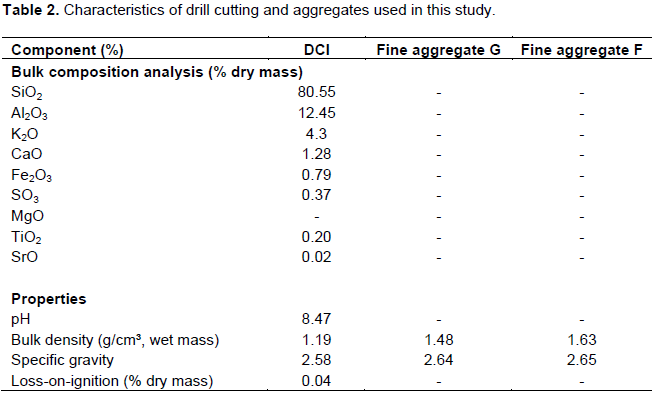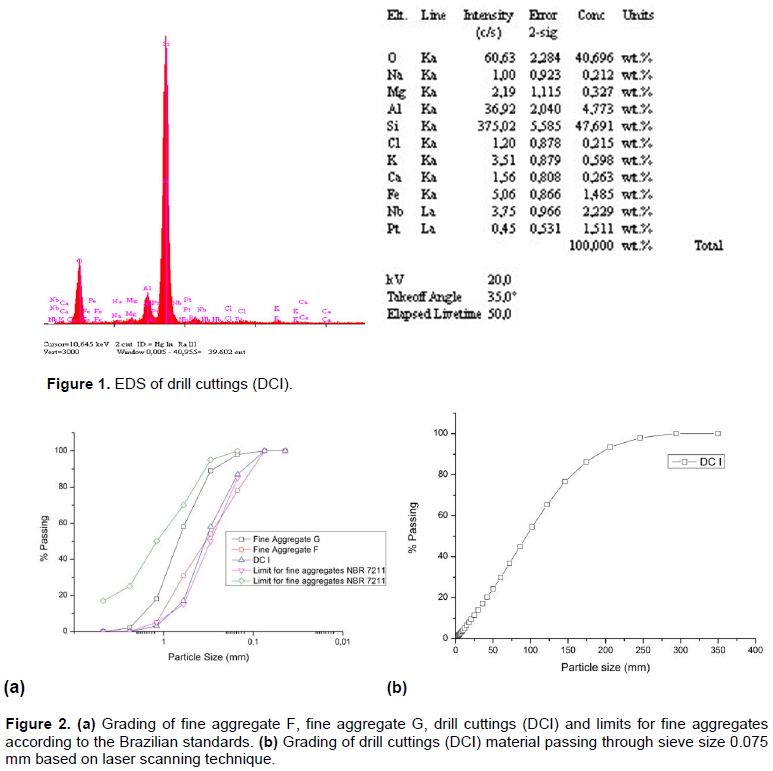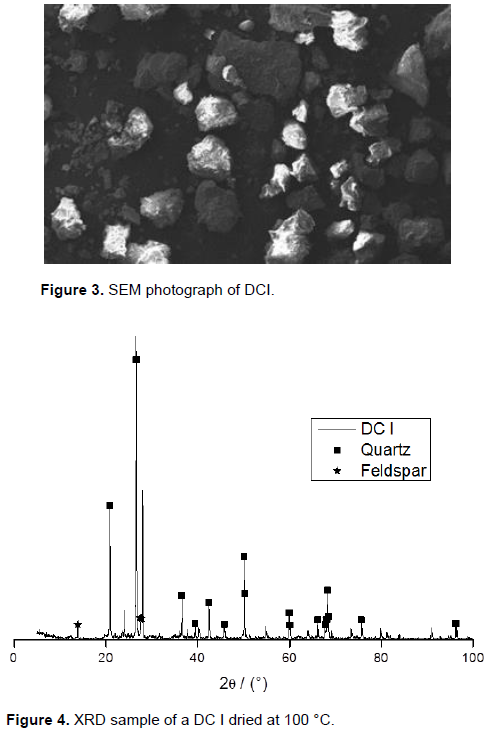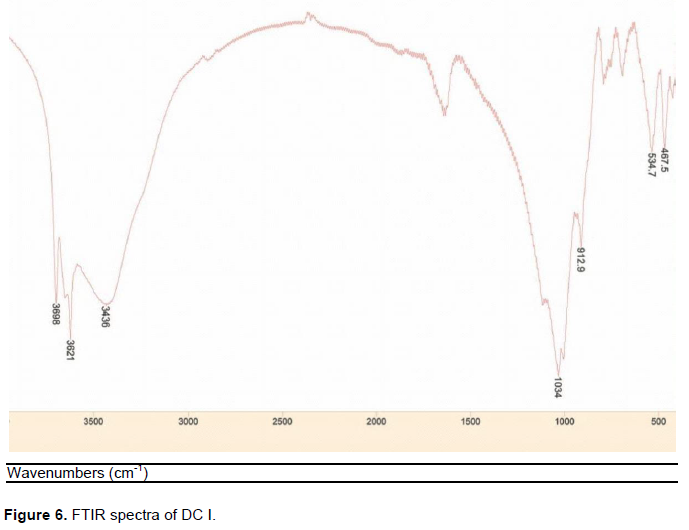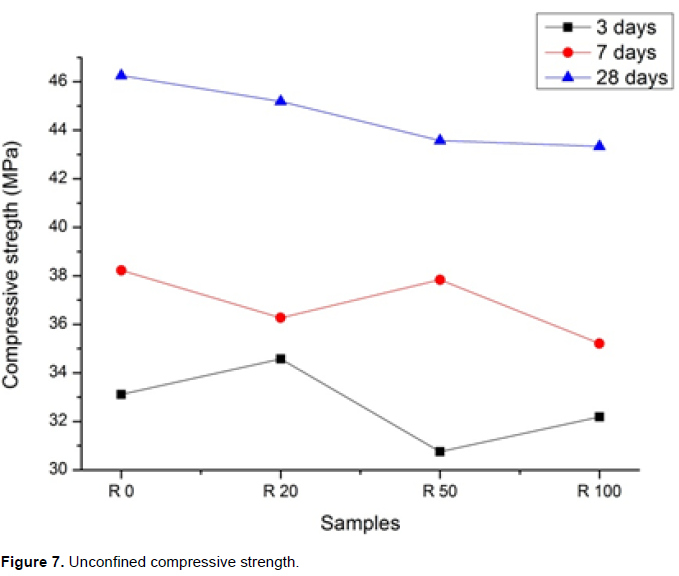ABSTRACT
Drill cuttings, generated in oil well drilling are managed to be disposed but will always have many environmental impacts. The innovation of this study was not only to produce a new and cost-effective material from drill cuttings, but also to mitigate its negative environmental impacts. Therefore, this article aims at characterizing and assessing behavior of drill cutting (DCI) deriving from well drilling activities in the State of Espírito Santo, Brazil, as a partial substitute to fine aggregate in concrete production. DCI was characterized using pH, X-ray Fluorescence Spectrometry (XRF), Fourier transform infrared (FTIR), X-ray diffraction (XRD), Thermo-gravimetric analysis (TG), Differential scanning calorimetry (DSC), and Scanning electron microscopy (SEM). The concretes produced had four percentages (0, 25, 50 and 100%) of their fine aggregate replaced with DCI. The study concretes were compared to one another regarding the variables compressive strength, Young’s modulus and microstructure. The results show that the use of drill cutting in cement-based materials is linked to its previous characterization. All the samples have shown mechanic results above the projected values. The microstructural properties were not affected by the DCI replacement. DCI concretes can be used in the ready-made material production, where there is stricter control of the raw-materials employed.
Key words: Drill cuttings, characterization, concrete materials, waste utilization.
Drill cuttings are tiny rock fragments impregnated with fluids used for lubricating and cooling down the drill during the oil well drilling process (Leonard and Stegemann, 2010). Managing this type of waste is one of the greatest concerns for the oil industry because of the significantly negative impact it causes to the environment due to the amount of inorganic and organic contaminants this material contains.
Exploration and development of drilling activities have expanded globally into such regions at the State of Espírito Santo, Brazil. In the State of Espírito Santo between 13 to 17 m3, drill cuttings produced estimates of one hundred vertical meters drilled onshore according to Company Petrobras (Petrobras, 2010). Generally, the use of water-based muds generates 7,00013,000 bbl of waste per well. Depending on the depth and diameter of the well, about 1,400 to 2,800 bbl of that amount are drill cuttings (EPA, 1993). The presence and concentration of drill cutting contaminants depend on the fluid used, the geological formation drilled, the well phase and the water used in the fluid preparation. The main contaminants can be divided into hydrocarbons, water-soluble salts and, in some cases, heavy metals (Reis, 1996).
The drilling is divided into phases, usually two to three according to depth. In each of them, the diameter of the well is decreased generating a smaller volume of waste, per meter drilled, and with different contaminants. The techniques available for treating and disposing drill cuttings are chosen according to the cutting contamination, the local laws and the producing company’s decision. Meanwhile, most of the drill cutting produced onshore in Brazil is disposed in dikes and landfills.
Some studies have been carried out in order to find a nobler destination to this material. In the civil construction industry, the studies on residue reuse point to stabilization/solidification of waste with Portland cement in concretes (Al-Ansary and Al-Tabbaa, 2007), including paving (Susich and Schwenne, 2004), landfill foundations (Dhir et al., 2010), unpaved road maintenance (Barnes, 2004), and ceramic materials (Pires, 2009; Chen et al., 2007).
According to these studies, the main problem that limits drill cutting reuse in concrete is the high concentration of organic components, and bentonite, which hinders the cement hydration process and decrease concrete compressive strength. It is important to highlight that most studies mentioned use waste that was taken from landfills or that was produced in labs, that is without strict control of the material and its contaminants. However, it is believed that waste derived from the first drilling stage can have different contaminant contents, which would offer better options of reuse.
Objectives and scope of this study
This study aimed at characterizing and assessing the potential use of drill cuttings obtained during the first drilling stage of oil wells, thermally pretreated at 100°C as partial replacement of sand in concrete production.
Themethodology adopted for characterizing the waste and analyzing the behavior of concretes produced using DCI instead of fine aggregate is described below. The study was divided into two stages. In the first stage the drill cuttings were characterized by the following tests: pH, DCI chemical, physical and microstructural characterization which was carried out using X-ray Fluorescence Spectrometry (XRF), infrared spectroscopy, grain grading analysis, SEM and X-ray diffraction, among other tests commonly used.
In the second stage, the study assessed the effect of substituting part of fine aggregates by different percentages of DCI (0, 25, 50, 100%) on mechanical properties and microstructure of concrete samples, based on compressive strength, Young's modulus, Scanning Electron Microscopy and X-ray diffraction.
Drill cuttings characterization
DCI was obtained during the first drilling stage of a well located onshore at Alegre’s Farm (18° 59’ 46’’ S; 39° 52’ 31’’ W) in Jaguaré, the north of Espirito Santo State, Brazil. After being gathered, the sample was taken to the Laboratory of Building Materials (LEMAC) at the Federal University of Espírito Santo (UFES), Brazil, where it was dried in oven at 100°C and characterized in terms of chemical, physical and microstructural properties.
Chemical and physical properties
The chemical properties included determining pH (pH meter), chemical composition using XRF and infrared spectroscopy (IV). The physical properties which include grain size distribution by sieving, as well as laser diffraction using a Sympatech particle analyzer. Density measurement was taken using Archimedes' principle.
Microstructural analysis
For DCI microstructural analyses, the study employed X-ray diffraction tests (XRD) with a XRD 6000 Shimadzu diffractometer using Cu Kα radiation, voltage 40 kV, current 200 mA and 2θ scanning, ranging between 10 and 90°C. Thermal analysis by DSC using DSC 50 Shimadzu; TG-DTG analysis performed in the range of 25 to 1000°C (stripping gas: air and heating rate:20°C/min) and SEM observations on EVO 40 Carl Zeiss scanning electron microscope are used for examination of micromorphological characteristics of drill cuttings in natura. The mold prepared for SEM analysis was sputter-coated with a conductive layer of gold.
Analysis of concrete samples
In order to determine mechanical behavior of concretes produced with DCI, cylindrical test specimens measuring 10x20 cm were molded using the following materials: cement CP V ARI (ABNT, 1991), river sand (identified as fine aggregate G), pit sand (identified as fine aggregate F), granitic gravel, superplasticizer and drill cuttings (DCI). Concrete mix design complied with method EPUSP/IPT (Helene, Terzian, 1992) and its ratios are presented in Table 1. Test specimens were unmolded after 24 h, identified and placed in tanks containing a supersaturated lime solution.
Mechanical behavior analysis of concrete
Test specimens were submitted to compressive strength tests at 3, 7 and 28 days, in compliance with Brazilian standard NBR 5739 (ABNT, 2007) and Young's modulus test at 28 days, in compliance with Brazilian standard NBR 8522 (ABNT, 2003).
Microstructural analysis of concrete
Scanning electron microscopy (SEM): In order to verify if the replacement with DCI caused any significant change in the hydrated cement paste and in the transition zone compared to reference, concrete samples were investigated using the previously described SEM.
The samples were randomly collected from the core of the six test specimens that had been submitted to compressive strength test at 3, 7 and 28 days. The samples had their hydration interrupted at every age studied through the addition of acetone P.A. for five days. With their surfaces metalized by a layer of gold, the images were obtained using a secondary electron detector (SED) and microanalysis of a few samples in specific areas which was carried out using the Energy Dispersive X-ray Spectrometer (EDS).
X-ray diffraction: The samples extracted from the test specimens undergoing compressive strength test at 28 days were collected randomly, ground for 10 sec in a disc mill and taken for mineral phase analysis through XRD. This analysis aimed at verifying whether any different mineral had been formed after interaction with DCI.
Drill cuttings characterization
Chemical and physical characterization
The chemical and physical characteristics of DCI are presented in Table 2. For comparison, the table also includes properties of the fine aggregates that would later be replaced with DCI in the composition of study concretes. The results obtained also show that DCI is alkaline, favoring its use in concretes, which need to keep their pH alkaline so as to avoid decalcification of the hydrated cement and consequent disaggregation (Priszkulnik, 2011).
Though EDS are presented in Figure 1, it is also possible to identify the intense presence of silicon, followed by elements oxygen, aluminum, iron, potassium, magnesium, calcium, chloride and sodium. DCI had its grain graded by sieving and the fractions passing through the 0.075 mm sieve were analyzed by laser diffraction. The results are shown in Figures 2a and b.
Based on grading analysis, we verified that DCI grain grading distribution which is most similar to that of sand F. Therefore, in the composition of concrete test specimens, only sand F was replaced with DCI, which would avoid a larger number of variables to be analyzed.
For DCI, the content of material passing through sieve 100 # was 13%. In the mass of this passing portion, it was observed that 4% of the whole sample contains silt. Clay fractions (< 2 µm) were not detected.
Microstructural analysis
Figures 3 and 4 show a SEM photograph and the results of x-ray diffraction of DCI, respectively. The presence of different shapes and sizes of DCI particles can be noticed. This result can be justified by the type of drilling tool used, which consists of a steel tooth that scrapes the rock formation.
The presence of clay minerals was detected in DCI through XRD. However, we recommend further and more in-depth analyses that include the preparation of oriented, heated, and solvation with ethylene glycol (or glycerol) blades in order to effectively verify the presence of these minerals (Albers, 2002). The diffractogram in Figure 5 shows that the mineral predominantly found in DCI was quartz, followed by feldspar (albite and microcline). The rock drilled belongs to Rio Doce formation (from 0m to 792m) in the sedimentary basin of Espírito Santo. Figure 5 shows the TG curve of DCI.
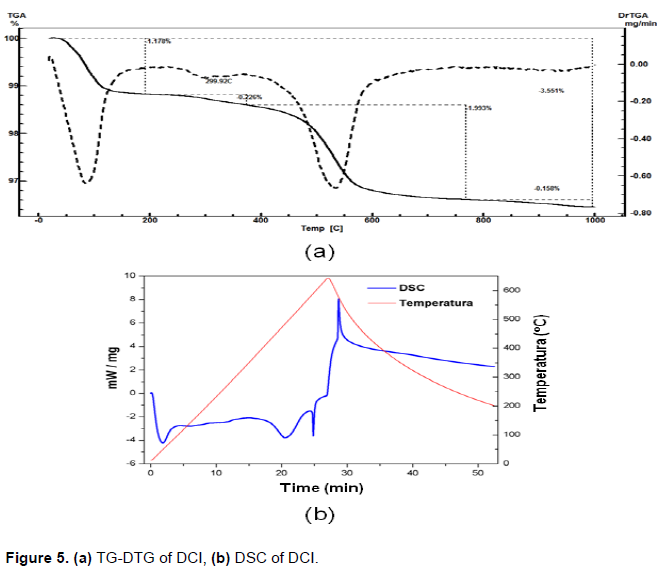
The TG curve DCI (Figure 5a) shows mass loss of 4%, which can be explained by water loss. This result can also be ratified by the loss on ignition test described in Table 2. The material can then be considered as inorganic and does not contain organic contaminants. DSC (Figure 5b) shows loss of water in the first broad endothermic peak and second acute endothermic peak, which means that quartz changed from its alpha-crystallin state to beta at 573°C (Santos, 1992) confirm the major presence of this mineral. Spectrum of infrared spectroscopy analysis is shown in Figure 6.
The bands present at 3436, 3621 and 3698 cm–1 correspond to stretching of OH, which indicates the presence of water. This water can be trapped between the lamellas of clay minerals. At 467.5 and 534.7 cm-1, the bands are associated to SiO deformations, whereas the bands at 912.9 and 1034 cm-1 are SiO stretching. All these vibrations are mainly characteristics of quartz.
Concrete analysis
Concrete mechanical properties
The average results of concrete compressive strength tests with substitutions of 0, 20, 50 and 100% at 3, 7 and 28 days are shown in Figure 7.
The results observed have a variation coefficient of 0.04% and the samples tested had density of 2330 kg/m³ ± 4%.The compressive strength values at 28 days are between 46.25 MPa and 43.34 MPa for the reference concrete (R 0) and substitution of 100% (R 100), respectively (Table 3). Results reveal that, the 100% substitution by DCI reduces compressive strength by 6.3% but the reduction in the consistency index increase the number of voids (Fialho, 2012).
Microstructural characterization confirms that, there was no delay in the reactions of hydration or formation of strange compounds. These findings suggest several options of reusing drill cuttings from the first drilling phase in cement-based building materials such as paving blocks, structural masonry blocks, curbs, stairs and other ready-made products that need lower compressive strength which are found.
Scanning electron microscopy (SEM)
Figure 8 shows the micrographic results of concrete samples obtained at 3, 7 and 28 days. It is noticeable that the micrographs show general characteristics associated to cement hydration products. The absence of ettringite, acicular tri-sulfur aluminate crystals of hydrated calcium looking like needles and sulfur aluminate of hydrated calcium was verified even in the first ages.
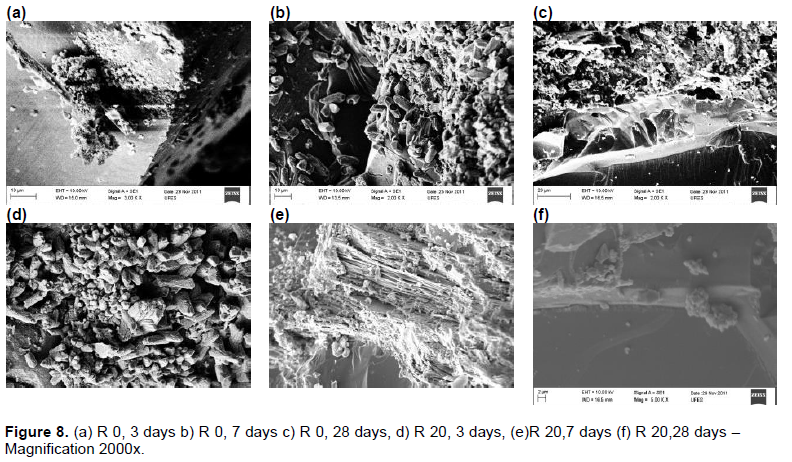
Micrographs at 3, 7 and 28 days show the evolution of fibrous crystals of hydrated calcium silicate looking like leaves and brad hexagonal prismatic crystals, that can be typical of portlandite (calcium hydroxide) and aluminate of hydrated calcium.
We can also see that the concretes presented are characterized by a compact structure. The structure of the pores in the three percentages evaluated does not show marked morphological changes compared to control. This can suggest that the presence of DCI did not influence the formation of hydrating products negatively. Clay minerals could not be seen either, because of their micro or nanometric dimensions. The microcrystals of most clay minerals can only be seen through transmission electron microscopy (TEM); only few can be observed through SEM (Coelho, 2012). Although compressive strength statistical analysis shows reduction among the groups, the microstructural analyses do not show visible differences between the samples analyzed. EDS chemical analysis shows that concretes with DCI
did not change their calcium and silicon contents, which means that there was no occurrence of pozzolanic reactions. This effect was already expected because of the absence of free silica and the waste grain grading (Taylor, 1964). The compressive strength results confirmed these findings.
X-ray diffraction (XRD)
Figure 9 shows the XRD results for concrete R 100. XRD results show that the characteristic peaks of reference concrete are quartz (silicon oxide), portlandite (calcium hydroxide), feldspar (microcline and albite) and alite (tricalcium silicate - C3S). The reference mixes R 20, R50 and R 100 contained quartz (silicon oxide), portlandite (calcium hydroxide), and feldspar (microcline and albite). No mineral considered deleterious to concrete was found. The conclusion is that replacing sand with DCI did not affect the mineralogical compositions in the study concretes.

Based on the test results, the following conclusions can
be drawn regarding DCI characterization:
(1) DCI values are considered normal for fine aggregate like grain size distribution, fineness modulus, maximum characteristic size, specific gravity, and unit gravity.
(2) DCI has an alkaline nature. X-ray Fluorescence analysis which are found as the main elements are expressed in its most stable oxides: silicone and aluminum.
(3) Energy dispersive X-ray identified elements sodium and chlorine, which may be an indication of the presence of small concentrations of sodium chloride.
(4) TG and DSC analyses indicate that, DCI is an inorganic but has free organic contaminations. The presence of quartz was also confirmed.
(5) X-ray diffraction and petrographic analyses identified quartz and feldspar as its main minerals. X-ray diffraction shows essentially crystalline nature. The rock drilled was sandstone in the Rio Doce formation.
Concerning the study concretes:
(1) The ratios tested reduce compressive strength significantly. However, they do not compromise Young's modulus.
(2) The microstructural properties of concrete were not affected. The micrographs presented show general characteristics associated to cement hydration products. Mineral which phases differently from expectations were found.
The authors have not declared any conflict of interests.
REFERENCES
|
Al-Ansary MS, Al-Tabbaa A (2007). Comparison of Stabilised/Solidified Mixed of Model Drill Cuttings Based on the North Sea and Red Sea Areas. SPE Publication 106799. SPE E&P Environmental and Safety Conference held in Galvesion, Texas. U.S.A., 5-7 March.
|
|
|
|
Albers AP, Melchiades FG, Machado R, Baldo JB, Boschi AO, Candido P, Castejón D, Campos SJ, Luiz RW, Carlos S (2002). Um método simples de caracterização de argilominerais por difração de raios X. Cerâmica 48(305):34-37.
Crossref
|
|
|
|
|
Associação Brasileira de Normas Técnicas (ABNT) (1991). NBR 5733 -Cimento Portland de alta resistência inicial. Rio de Janeiro (in portuguese).
|
|
|
|
|
Associação Brasileira de Normas Técnicas (ABNT) (2007). NBR 5739 - Concreto - Ensaios de compressão de corpos-de-prova cilíndricos. Rio de Janeiro, (in portuguese)
|
|
|
|
|
Associação Brasileira de Normas Técnicas (ABNT) (2003). NBR 8522 - Concreto - Determinação do módulo estático de elasticidade à compressão. Rio de Janeiro (in portuguese).
|
|
|
|
|
Barnes GR (2004). Onsite Treatment of Oily Drilling Waste in Remote Areas. SPE Publication 88487. SPE Asia Pacific Oil and Gas Conference and Exhibition, 18-20 October, Perth, Australia.
Crossref
|
|
|
|
|
Chen TL, Lin S, Lin ZS (2007). An Innovative Utlilization of Drilling Wastes as Building Materials. SPE Publication 106913. SPE E&P Environmental and Safety Conference held in Galvesion, Texas. U.S.A., 5-7 March.
|
|
|
|
|
Coelho ACV, Santos de Souza P, Santos de Souza H (2012). Argilas especiais: o que são, caracterização e propriedades. Quím. Nova, São Paulo, 30, n. 1, fev. 2000. Disponível em:
<View>. Acesso em 02 mar. 2012. (in portuguese)
|
|
|
|
|
Dhir RK, Csetenyl LJ, Dyer TD, Smith GW (2010). Cleaned oil-drill cuttings for use as filler in bituminous mixtures. Construction and Building Materials 24:322-325.
Crossref
|
|
|
|
|
EPA (1993). Development Document for Effluent Limitation Guidelines and Standards for the Offshore Subcategory of the Oil and Gas Extraction Point Source Category.
View
|
|
|
|
|
Fialho PF (2012). Cascalho de Perfuração de Poços de Petróleo e Gás. Estudo do Potencial de Aplicação em Concreto (Master's thesis, Universidade Federal do Espírito Santo).
|
|
|
|
|
Helene P, Terzian P (1992). Manual de Dosagem e Controle do Concreto. São Paulo: Pini (in portuguese).
|
|
|
|
|
Leonard SA, Stegemann JA (2010). Stabilization/solidification of petroleum drill cuttings. J. Hazard. Mater. 174:463-472.
Crossref
|
|
|
|
|
PETROBRAS (2010). Exploração e Produção de petróleo e gás. Disponível em:
<View>. Acesso em: 01 fev. 2010.
|
|
|
|
|
Pires PJM (2009). Utilização de cascalho de perfuração de poços de petróleo para a produção de cerâmica vermelha. 173f. Tese (doutorado em Engenharia civil) – Pontifícia Universidade Católica do Rio de Janeiro. Rio de Janeiro (in portuguese).
|
|
|
|
|
Priszkulnik S (2011). Ações Físicas e químicas na durabilidade do Concreto. In: ISAIA, G. C.(Org.) Concreto Ciência e Tecnologia. São Paulo: Instituto Brasileiro do Concreto, 2(2):1003-10028.
|
|
|
|
|
Reis J (1996). Environmental Control in Petroleum Engineering. 1st Ed, Houston, Texas, Gulf Publishing.
|
|
|
|
|
Santos PS (1992). Ciência e Tecnologia de Argilas. 2ª ed. São Paulo: Edgard Blücher Ltda., 408p.
|
|
|
|
|
Susich ML, Schwenne MW (2004). Onshore Drilling Waste Management: Beneficial Reuse of Cuttings. SPE Publication 86732. SPE International Conference on Health, Safety, and Environment in Oil and Gas Exploration and Production, 29-31 March, Calgary, Alberta, Canada.
Crossref
|
|
|
|
|
Taylor HFW (1964). The Chemistry of Cements. London & New York: Academic Press.
|
|

